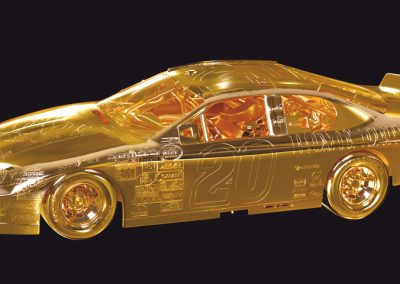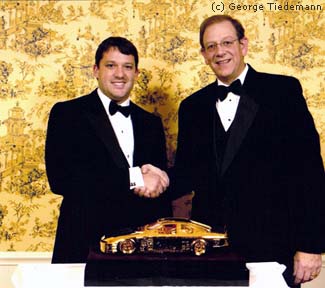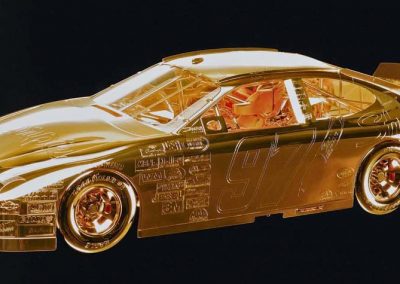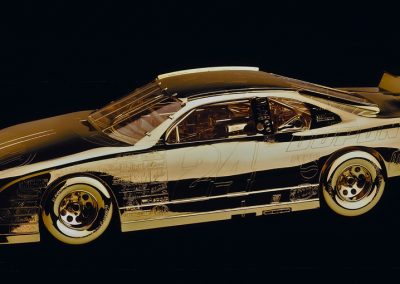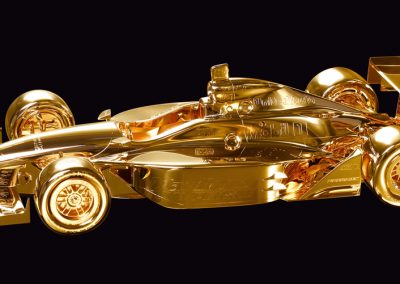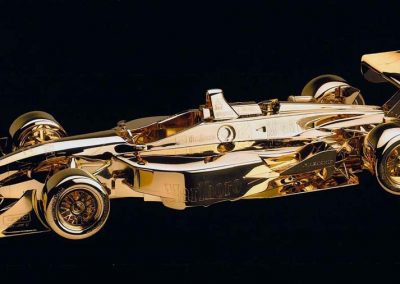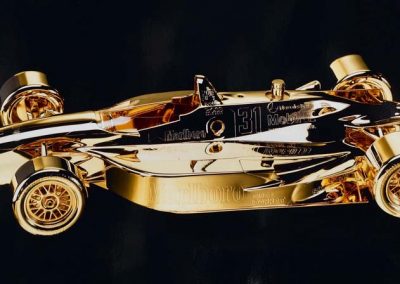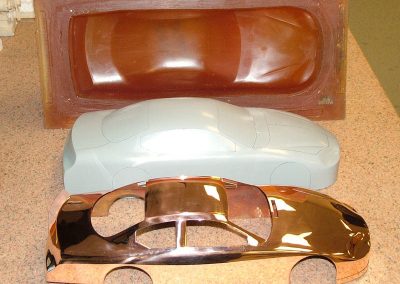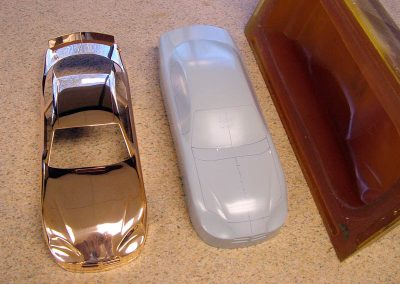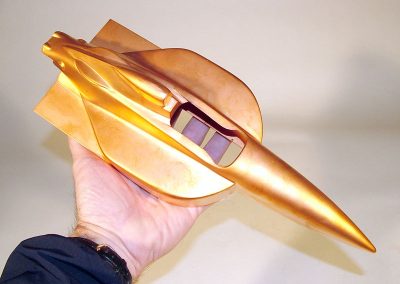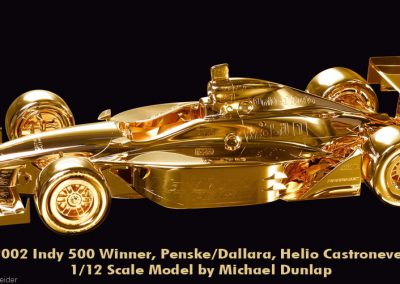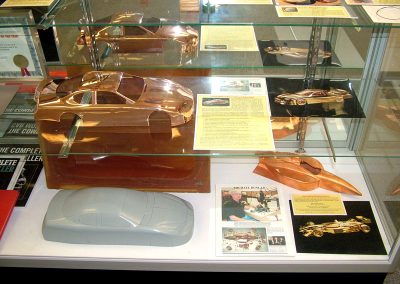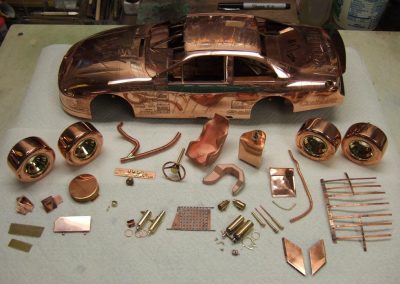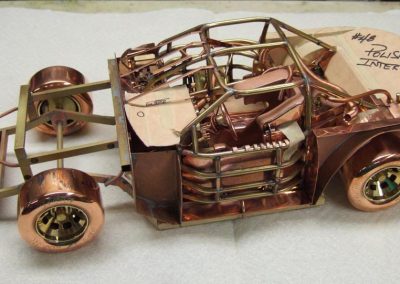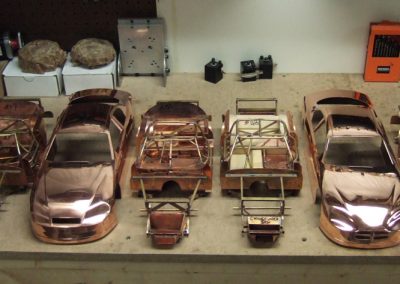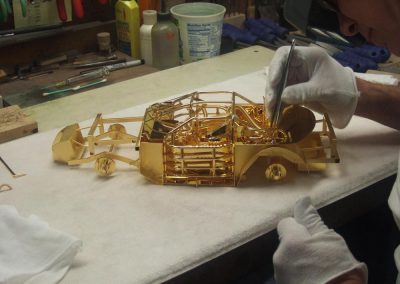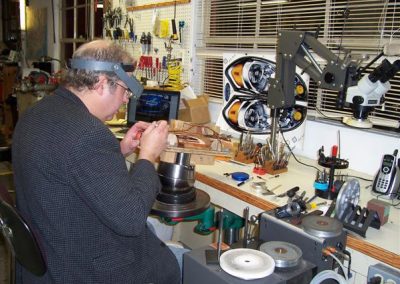Below you can view more photos of Mike’s gold car models. Click on images to enlarge.
Gold Cars
Tony Stewart’s Gold #20 Home Depot Chevrolet
This is 2005 Nextel Cup Champion Tony Stewart’s scale model #20 Home Depot Chevrolet. Like all of these gold cars, it is 1/12 scale, gold plated, and engraved.
Tony Stewart Receiving His Gold Car
Tony Stewart is seen receiving his award from Goodyear chairman, Jon Rich.
Kurt Busch’s Gold #97 Sharpie Ford
This is 2004 Nextel Cup Champion Kurt Busch’s #97 Sharpie Ford gold car. Mike starts the racing season modeling each of the three potential winners—Ford, Chevrolet, and Dodge. If the championship winner isn’t decided until the final race, Mike only has two weeks to finish the winning car, and have it engraved and plated before it’s presented at the NASCAR awards ceremony. Often a courier flies the car from Mike’s shop directly to the awards ceremony, arriving only hours before the presentation.
Jeff Gordon’s Gold #24 DuPont Chevrolet
The 2001 Winston Cup Champion Jeff Gordon’s #24 DuPont Chevrolet gold car.
Helio Castorneves’ Gold #3 Penske/Dallara
The 2002 Indy 500 winner Helio Castorneves’ #3 Penske/Dallara gold car. Though the cars may appear similar, every year to year change, no matter how small, is incorporated into the model for a particular year.
Gil Deferan’s Gold #2 Penske/Raynard
The 2000 CART Champion Gil Deferan’s #2 Penske/Raynard gold car, which also commemorated Roger Penske’s 100th victory.
Al Unser Jr.’s Gold #31 Penske PC-23
The 1994 Indy 500 winner Al Unser Junior’s #31 Penske PC-23 gold car.
Dodge Charger Body, Mold, and Copper Electroform
In January, 2008 Michael donated to the Craftsmanship Museum a 2005-06 Dodge Charger carved plaster body original, urethane mold pulled from the original, and a copper electroformed body made from the urethane mold. The body has had extensive work done on it that includes: installation of the gas filler cap, air box, B-pillar, rear spoiler, front air dam, and strengthening under the top. The body is highly polished. Once it became clear that a Dodge would not win the 2007 championship, work on this body was stopped.
Dodge Charger Body, Mold, and Copper Electroform
We also thank Goodyear Tire & Rubber Company, who commissioned Michael to make these models, for their permission to display this. Normally, unused bodies are destroyed. Only the top NASCAR driver gets one of these each year, so we are proud to be able to display this for viewers to see the craftsmanship that goes into one of racing’s best made trophies.
Unpolished Copper Electroform IndyCar Body
Michael also provided this unpolished copper electroformed body, which is like the one used to complete the Penske/Dallara IndyCar, driven by Helio Castroneves to win the 2002 Indy 500. The electroformed body is now also part of Michael’s display in the Craftsmanship Museum.
Construction Details
Components for Matt Kenseth’s DeWalt Ford
Interior components for Matt Kenseth’s DeWalt Ford are laid out in front of the finished body.
Rolling Chassis for Jimmy Johnson’s #48 Lowes Car
The rolling chassis for Jimmy Johnson’s #48 Lowes car is ready for polishing before gold plating.
Several Chassis and Bodies
A Ford chassis, a Chevrolet body, two Chevy chassis, a Dodge body, and a Dodge frame all had to be built to assure having the right car at the end of the season. The Ford body that is missing had already been sent to the engraver, and would be fitted to the Ford chassis. The rest is scrap.
Mike Working on a Car
Mike is seen at the workbench positioning electrical wire details during final assembly.
Engraver Rex Pederson at Work
Engraver Rex Pederson has one of the last jobs on the cars before final assembly. Headlights are engraved by hand from drawings, and a pantograph engraver is used to do all the numbers and small sponsor decals. At this point, the car is gold plated, and the body finished—mistakes are not an option. As Joe Martin noted, you have to work on a part that has this many hours of work in it differently than you would work on one that could be easily remade. A high level of focus, and an attitude that accepts nothing less than perfection are needed—in addition to practiced skill.

